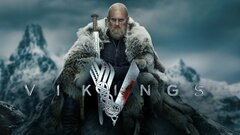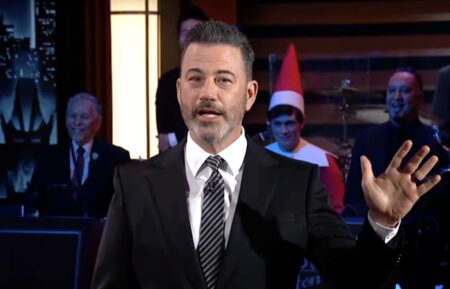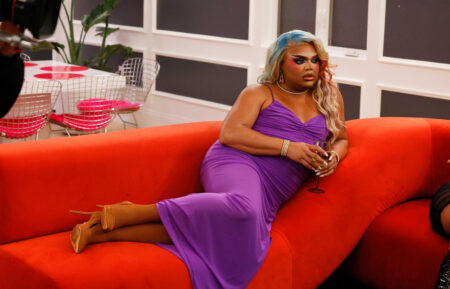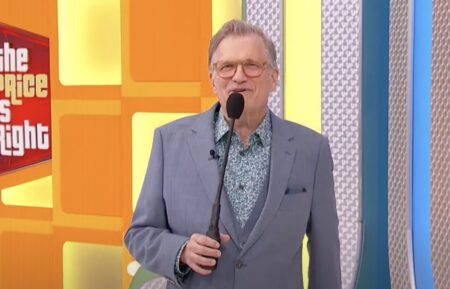Vikings Death: The Latest Casualty Talks Frightening Filming, Parting Gifts and Who’s Responsible
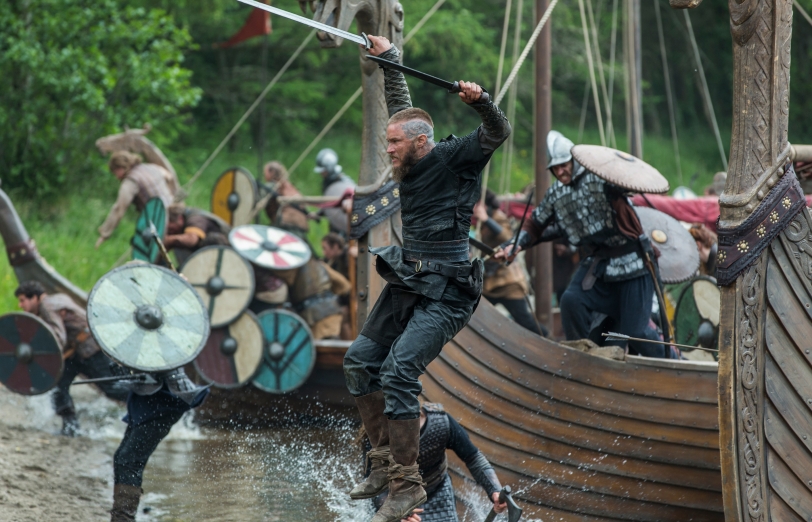
Warning: Spoilers about the March 12 episode of Vikings ahead.
The past sacrificed itself for the future on Vikings when wise and brave widow Siggy (Jessalyn Gilsig) drowned in a frozen-over Scandinavian lake after saving two very young boys who had fallen through the ice. The children are the future warriors and leaders of the Vikings, and the sons of Norse king Ragnar Lothbrok (Travis Fimmel), the man who killed Siggy’s husband.
When we first met Siggy in Season 1, she was the rich, bejeweled wife of Earl Haraldson (Gabriel Byrne.) The power couple presided over the Viking town of Kattegat from their fur-draped thrones in the Great Hall until Ragnar killed the Earl in a duel. After that Siggy lost her last surviving child and her position but never her will to keep the Viking people strong.
She became a servant and advisor to Ragnar’s first wife Lagertha (Katheryn Winnick), found love with Ragnar’s brother Rollo (Clive Standen); was an integral part of a plot to save her people from treacherous King Horik (Donal Logue) in Season 2; and finally helped care for Ragnar and his second wife Queen Aslaug’s (Alyssa Sutherland) children, for whom she died in Thursday’s episode.

Thanks to Siggy, the future is alive but it will be harder for it to thrive without her experience and watchfulness. We asked Gilsig about shooting Siggy’s death scene, how dangerous that mysterious wanderer Harbard (Kevin Durand) really is, and what she’ll miss most about working on Vikings. The show just won’t be the same without her excellent suspicious side-eye.
How did Vikings creator and showrunner Michael Hirst break the news to you that Siggy was going to die?
Well, the truth is, I broke the news. I had some family things that needed my attention and I couldn’t live [in Ireland] and do what I needed to do on behalf of my family. It was really tough. I approached Michael and the producers at the end of Season 2 and they couldn’t have been more understanding. Michael and I talked about how we wanted to make sure we could carve out enough time to give Siggy some closure. And obviously, Michael did such a beautiful – such an incredible job. It was one of the hardest decisions I’ve ever made, naturally.
Did Michael try to talk you out of leaving?
He was so great about it. He was like, “Wait. But we have so many ideas!” But some things in life are bigger [than work.] I was the only one to do what needed to be done, so I had to do what I had to do.
What was the biggest challenge of shooting Siggy’s drowning scene?
The challenge, of course, was the children. I was so worried about the kids. You never want to say to a child, “No, stay underwater.” Any child’s instinct is to come up and find air. You can hardly hold a kid down. So we talked a lot. There was a lot of planning about how we could capture the children [in shots] but make sure that their safety and comfort was paramount. The kids were wonderful but we also worked with dummies and angles [to get what we needed.]
How many days did it take to shoot?
It took us two days, three with rehearsal. Part of it we did in an outdoor swimming pool, and then part of it we did in a tank – all in Ireland.
Were you ever scared?
The most difficult was the actual drowning because they tie a rope to your waist and pull you underwater. That sensation of being pulled and having no control and having to relax into it is so counterintuitive. I would make this gesture across my neck saying when I was done. The first time I did it, I said, “Wow, that was a long time. How long was that?” And they were like, “It was four seconds.” I thought, I’ve got to rehearse. So I practiced in the bathtub at home to hold my breath underwater and be relaxed about it.
Had you ever shot underwater before?
I did a film called The Flood many years ago in South Africa. I remember accepting the job and then being on a plane to South Africa and suddenly realizing that it was going to be three months in water. This was easier than that [laughs].
Siggy surfaces twice when rescuing the boys. The first time she sees a vision of Thyri, the daughter who died from plague in Season 1, and this seems to give Siggy some peace.
Exactly. It’s that idea of, she’s tired, and her family is saying, “You can let go.” That’s what Michael and I talked about, this idea of like, okay, no more fighting.
The second time Siggy surfaces she sees Harbard, whom she confronted earlier. Is he real or a vision at that moment and is he somehow responsible for Siggy’s death? Did he lure those boys onto the ice for her to follow?
As I understand it, his storyline will continue and there are more dimensions to Harbard and who he is. Siggy knows that from the moment he shows up. There’s nothing that happens in Kattegat that Siggy hasn’t seen before. She knows what he represents. She’s trying to sound the alarm, but everyone else is so naïve and doesn’t understand. It’s so obvious to her the danger that he brings.
So is he responsible for her death?
He certainly didn’t save her.
A moment in this episode that became even more poignant after Siggy died happened earlier, when she was alone in the Great Hall and sat in what was once her throne. Was that something that you brought up to Michael that you wanted to do?
Yeah. I did. We had a long talk. I talked to Michael about how one of the things that made me so sad about leaving was that Siggy would never sit there again. Those scenes in the Great Hall were really important to me because I always thought of it as Siggy’s old home, her old position. Her understanding of why she’s outlived her entire family is that she’s working to get back to that position. Every time she’s in the Great Hall, she’s imagining taking that seat. Siggy was just such a fun character because she was so solitary but always thinking and always conscious. In that scene, we don’t know as an audience it’s the end; it has the feeling of a beginning with a sense of nostalgia for what had been.
Siggy’s lover, warrior Rollo (Clive Standen) has already suffered so much, can he cope with losing her?
I would joke with Clive all the time, “So basically Rollo is catatonic at this point I’m assuming. He’s not going to go on, is he?” But then it’s like, no, definitely, you’re going to go on.
Rollo is a survivor, for sure. Are you going to miss kidding around with the cast?
Yeah, we’re really tight. I’m so jealous that they get to go back [to set.] They’re going to be sitting in our little tents in the rain telling dirty jokes. I don’t get to be there, and that sucks. But they come through LA. But the crew, most are based in Ireland. I made such incredible friends. We lived there and had a life there. To walk away from those relationships after three years, that’s a great loss. I have sisters there now, and I’ve got to see them. When the time is right, I’ll definitely go back.
Did you take a Siggy keepsake with you?
Joan [Bergin, the Vikings costume designer] designed and had this beautiful necklace made for me that had all these Viking symbols on it that have to do with fertility and motherhood. It was such an incredibly thoughtful gift.
Will you miss those costumes, hair and makeup?
I should have taken one of my hair extensions. It was such an incredible transformation to go from contemporary life into that long hair. I miss that. That hair did so much of the work for you. The hair and makeup design on that show is so underrated. If you could see how we show up in the morning, and how we walk out of the hair and makeup rooms, you’d know how creative they are.
What is Siggy’s legacy on this show?
The way I always think of Siggy is that she’s the end of the Haraldson era. Gabriel Byrne and I would talk about it, like we were the Bushes, and they [the Lothbroks] are the Obamas. We’re the past. Siggy was the last one. What was so frustrating for her is she always felt like she was a resource that wasn’t being tapped. And now they’re kind of on their own, without that wisdom of experience.
How did being part of this show affect you?
Vikings is the absolute illustration of why I became an actor. It’s about finding that bridge between storytelling and real life and trying to make that connection with an audience and give them an experience. This show about a completely under-explored era in history has made such a connection. The audience has gotten it in a very deep and humane way. It’s a credit to Michael who never wanted the Viking characters to be supernatural or heroes. They’re just people making their way. As an actor, it was amazing to give yourself over to it working in that environment so close to elements and away from LA. I carry that forward into the work I do. I needed that touchstone.
What’s next for you?
I did a pilot for USA with Dallas Roberts, but it didn’t get picked up. I did a couple episodes of Glee for the last season. It was so much fun and a totally different pace. It’s so funny to go between the two worlds. It cracks me up. So now, back to the streets, as they say.
Is there any chance we’ll see Siggy again, maybe in a dream or as a ghost or vision?
I always joked with Donal Logue (who played King Horik, killed by Ragnar in Season 2) that we should do a multi-camera sitcom called Valhalla where everybody who’s died on Vikings shows up and hangs out in a bar. That would be my pitch [laughs].

